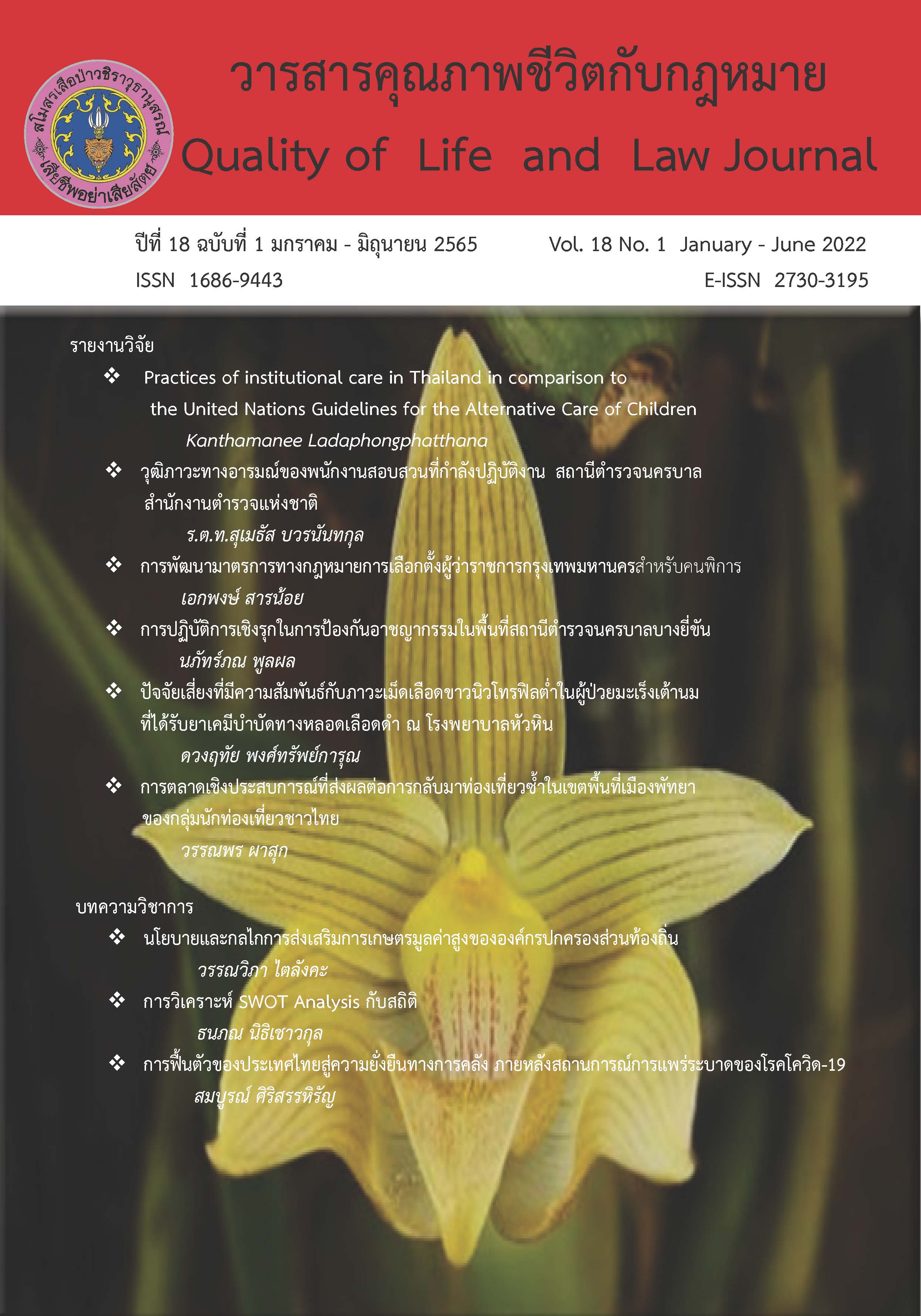Risk factors for neutropenia in breast cancer patients receiving intravenous chemotherapy in Hua-Hin hospital
Main Article Content
Abstract
This research aims (1) to study risk factors associated with neutropenia, (2) to study chemotherapy risk factors associated with febrile neutropenia, and (3) to study association between neutropenia and febrile neutropenia in breast cancer patients receiving intravenous chemotherapy. The sample used in the research includes medical records of 320 breast cancer patients treated with intravenous chemotherapy. Data analysis using descriptive statistic e.g. percentage, frequency distribution, and inferential statistic e.g. Chi-square.
The result showed that (1) patient risk factor, disease risk factor, and chemotherapy regimen are not associated with neutropenia. However, chemotherapy cycle is statistically associated with neutropenia in breast cancer patients receiving intravenous chemotherapy (p-value <0.001). (2) The chemotherapy cycle is statistically associated with febrile neutropenia in breast cancer patients receiving intravenous chemotherapy (p-value <0.001). (3) Neutropenia is statistically associated with febrile neutropenia in breast cancer patients receiving intravenous chemotherapy (p-value <0.001).
Article Details

This work is licensed under a Creative Commons Attribution-NonCommercial-NoDerivatives 4.0 International License.
- บทความหรือข้อคิดเห็นใดๆ ในวารสารคุณภาพชีวิตกับกฎหมายเป็
- กองบรรณาธิการไม่สงวนสิทธิ์
References
คณะแพทยศาสตร์ศิริราชพยาบาล มหาวิทยาลัยมหิดล ส่วนข้อมูลข่าวสารสาธารณสุข. (2560). สถิติสาธารณสุข. สำนักนโยบายและยุทธศาสตร์ สำนักงานปลัดกระทรวงสาธารณสุข.
มงคล ตาสุข. (2551). ปัจจัยที่มีผลต่อการเกิดภาวะเม็ดเลือดขาวนิวโทรฟิลต่ำในผู้ป่วยโรคมะเร็งเต้านมที่ได้รับเคมีบำบัดสูตร FAC ณ โรงพยาบาลนครพิงค์ จังหวัดเชียงใหม่. วิทยานิพนธ์เภสัชศาสตร์มหาบัณฑิต มหาลัยเชียงใหม่.
สถาบันมะเร็งแห่งชาติ กรมการแพทย์ กระทรวงสาธารณสุข. (2562). ข้อเสนอแนะการตรวจคัดกรองมะเร็งเต้านมที่เหมาะสมสำหรับประเทศไทย. สถาบันมะเร็งแห่งชาติ กรมการแพทย์ กรมอนามัย มูลนิธิ์ถันยรักษ์.
สำนักงานสาธารณสุขจังหวัดประจวบคีรีขันธ์. (2563). ระบบข้อมูลสารสนเทศสำนักงานสาธารณสุขจังหวัดประจวบคีรีขันธ์. สืบค้น 15 มกราคม 2563 จาก http://203.157.159.10/reports/ca.php.
หทัยวรรณ รัตนบรรเจิดกุล.(2554). การศึกษาความสัมพันธ์ระหว่างภาวะอัลบูมินในเลือดต่ำกับการเกิดภาวะเม็ดเลือดขาวชนิดนิวโทรฟิลต่ำจากการรักษาด้วยยาเคมีบำบัดครั้งแรกในผู้ป่วยมะเร็งเต้านม. สืบค้น 15 มกราคม 2563. จาก http://thesis.grad.chula.ac.th/readfile1.php?fn=ab5374669830.docx.
อาคม เชียรสิลป์. (2538). หลักการดูแลรักษาผู้ป่วยโรคมะเร็งด้วยวิธีของเคมีบำบัด. วารสารโรคมะเร็ง, 11(1), 36-48.
Crawford J, Dale DC, & Lyman GH. (2004). Chemotherapy-induced neutropenia: Risks, consequences, and new directions for its management. Cancer, 100, 228-237.
Crawford J, Wolff D, Culakova E, Ponlewierski MS, Selby C, Dale D. (2004). First-cycle risk of severe and febrile neutropenia in cancer patients receiving systemic chemotherapy: Results from a prospective nationwide study in Poster presented at the 46th Annual Meeting of the American Society of Hematology. USA: Atlanta, GA.
Eskander RN, & Tewari KS. (2012). Impact of chemotherapy-induced neutropenia on survival in patients with breast, ovarian and cervival cancer: A systematic review. Journal of hematological malignancies, 2(3), 63-73.
Fisher B, Dignam J, Mamounas EP,et al.(1996). Sequential methotrexate and fluorouracil for the treatment of node-negative breast cancer patients with estrogen receptor-negative tumors: eight-year results from National Surgical Adjuvant Breast and Bowel Project (NSABP) B-13 and first report of finding from NSABP B-19 comparing methotrexate and fluorouracil with conventional cyclophosphamide, methotrexate,and fluorouracil. J Clin Oncol, 14(7), 182-192.
Fortner BV, Tauer KW, T, Houts AC, & Schwartzberg LS. (2005). Experiencing neutropenia: quality of life interviews with adult cancer patients. BMC Nursing.
Jenkin J,Griggs J, Culakova E, et al. (2007). Effect of patient Socioeconomic Status and Body mass index on the Ouality of Breast Cancer Adjuvant Chemotherapy. J Clin Oncal, 25, 277-284.
Keswara MA, Sudarsa IW, & Golden N. (2012). The risk factor of neutropenia on locally advance breast cancer patients treated with first cycle cyclophosphamide, doxorurbicin, 5-fluorouracil chemotherapy at Sanglah General Hospital Denpasar, Bail-Indonesia. Ball Medical Journal (BMJ), 1(3), 116-120
Khan S, Dhadda A, Fyfe D, & Sundar S. (2008). Impact of neutropenia on delivering planned chemotherapy for solid tumours. European journal of Cancer Care, 17, 19-25.
Leonard R, Miles D, Thomas R, & Nussey F. (2003). Impact of neutropenia on delivering planned adjuvant chemotherapy: UK audit of primary breast cancer patients. British Journal of Cancer, 89, 2062-2068.
Lóopez-pousa A, Rif J, Cassas De Tejerina A, GonzÂiez-Larriba JL, lglesias C, & Gasquet JA. (2010). Risk assessment model for first-cycle chemotherapy Induced neutropenia in patients with solid tumours. European Journal of Cancer Care, 19, 648-655.
Lyman GH, Dale DC, Crawford J. (2006). Incidence and predictors of low dose-intensity in adjuvant breast cancer chemotherapy: a nationwide study of community practices. J Clin Oncol, 21, 124-131
Matthias S,Chirstian J et al.(2005). Neutropenic event risk and impaired chemotherapy delivery in six European audits of breast cancer treatment. Supportive Care in Cancer, 14, 901-909.
Nascimento TG, Andrade MD, Oilverira RA, Almeida AM, & Gozzo TO. (2014). Neutropenia: Occurrence and management In women with breast cancer receiving chemotherapy. Rev. Latino-Am. Enfermagem, 22(2), 301-308.
Ozer H. (2015). The timing of chemotherapy-induced neutropenia and its clinical and Economic impact. Retrieved August 3, 2020 From http://www.cancernetwork.com/oncology-journal/timing-chemotherapy-induced-neutropenia-and-its-clinical-and-economic-impact.
Poikonem P, Blomqvist C. (2001). Joensuu H.Effect of obesity on the leukocyte nadir in women treated with adjuvant cyclophosphamide,metrotrexate,and fluorouracil dosed according to body surface area. Acta Oncal, 40, 67-71
Pettengell R, Schwenkglenks M, Leonard R, Bosly A, Paridaens R, & Constenla M. (2008). Neutropenia occurrence occurrence and predictors of reduced chemotherapy dellvery: result from the INC-EU prospective observational European neutropenia study. Support Care Cancer, 16, 1299-1309.
Repetto L. (2009). Incidence and clinical impact of chemotherapy induced myelotoxicty in cancer patients: An observational retrospective survey. Critical Reviews in Oncology/Hematology, 72, 170-179.
Rocconi, RP., Matthews, KS., Kemper, MK., Hoskins, KE., & Barnes, MN. (2008). Chemotherapy-related myelosuppression as a marker of survivai in epithellal ovarian cancer patients. Gynecol, 108(2), 336-341.
Schwenkglenks M, Jackisch C, Constenal M, Kerger JN, Paridaens R, & Auerbach L. (2006). Neutropenic event risk and impaired chemotherapy delivery in six European audits of breast cancer treatment. Support Care Cancer, 14, 901-909.
Schwenkglenks M, Pettengell R, Jackisch C, Paridaens, Constenla M, & Bossly A. (2011). Risk factors for chemotherapy-induced neutropenia occurrence in breast cancer patients: Data from the INC-EU prospective observational European neutropenia study. Support Care Center, 19, 483-490.
TCB Report Online. (2563). หน่วยทะเบียนมะเร็งโรงพยาบาลหัวหิน. สืบค้น 15 มกราคม 2563 จาก http://tcb.nci.go.th/CWEB/cwebBase.do?mode=initialApplication.


